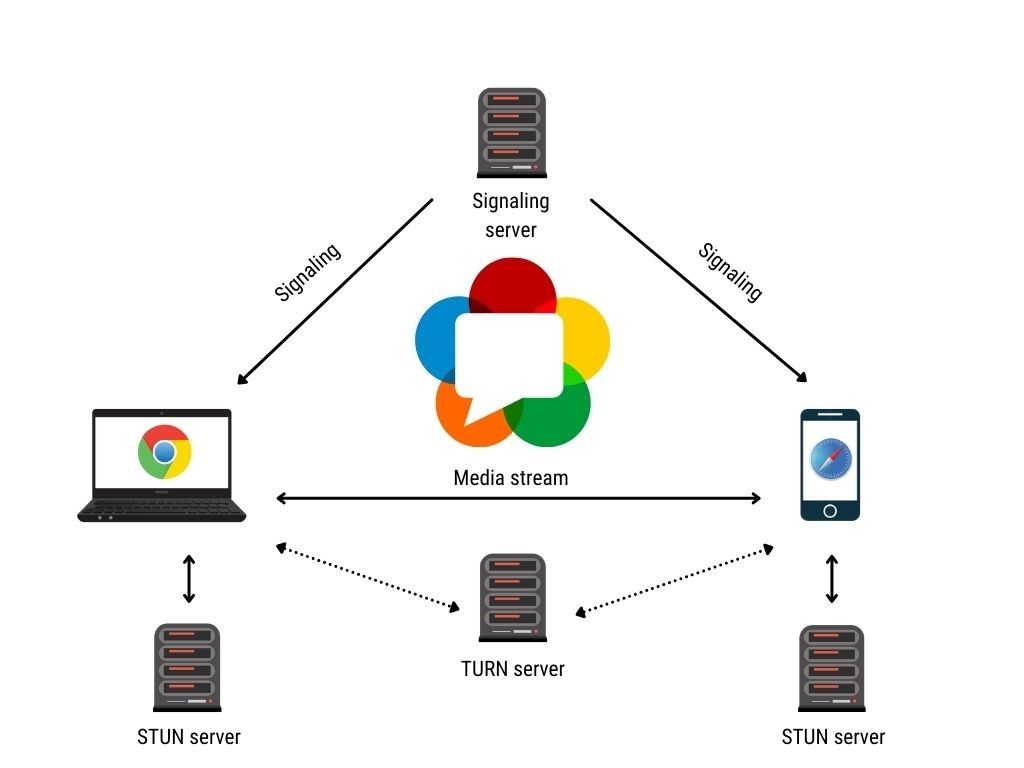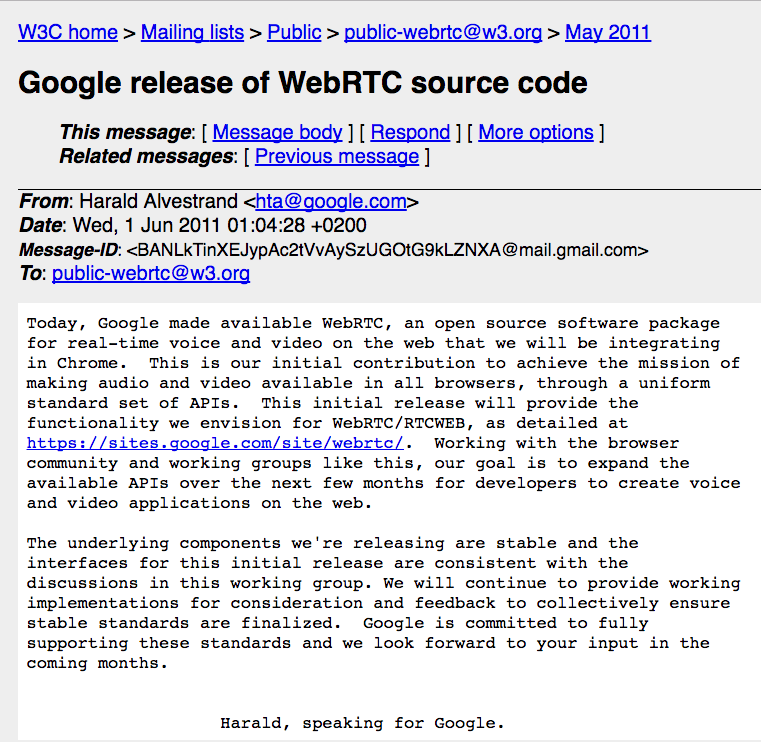
How is WebRTC transforming the communication landscape
Last Updated on September 27, 2021
WebRTC is a technology that provides any browser with the ability to share application data and conduct peer-to-peer audio and video conferences without installing plugins or third-party software. In January 2021, WebRTC became a W3C Recommendation and IETF Standard. In the last year, due to the coronavirus epidemic, millions of people have experienced a lot of changes on their daily routines and the use of audio and video real-time conferencing solutions has been encouraged to reduce physical contact. The WebRTC standardization encourages the widespread adoption of one of the most used technologies during the COVID-19 pandemic situation.
Table of Contents
WebRTC : A little bit of history
The need for web remote collaboration and video conference has been around for a while. A few years ago, the solution to perform this was to install software or plugins on a PC which required and effort from the users and complex stacks and protocols for the developers.
In May 2010, Google acquires Global IP Solutions (GIPS) a company that has developed many VOIP and video calling components. Google open sourced GIPS technology and added a Javascript API as an integration layer for web browsers.
In 2011, Google partnered with the W3C (The World Wide Web Consortium) and the IETF (Internet Engineering Task Force) to assess, develop and standardize an open source framework for bringing real-time interactive communications to web browsers. The same year W3C published the first WebRTC spec draft. WebRTC was born!
In November 2017, the WebRTC 1.0 specification is announced “feature complete” by the W3C and transitioned from Working Draft to Candidate Recommendation.
In January 2021, the WebRTC 1.0 specification transitioned from Candidate Recommendation to Recommendation. The W3C and the IETF announced that WebRTC has undergone extensive review and testing and is now an official standard, bringing audio and video communications anywhere on the Web and encourages its widespread adoption.
How does WebRTC work?
WebRTC is composed of three main Javascript APIs: MediaStream, RTCPeerConnection and RTCDataChannel.
- MediaStream with its getUserMedia method enables access to device camera and microphone to acquire the audio and video media.
- RTCPeerConnection allows the application to establish peer-to-peer communications with another endpoint, for instance an RTCPeerConnection in another browser. These communications are coordinated by a signaling protocol which is out of WebRTC scope (generally via a script using WebSocket connection to one or more external servers).
- RTCDataChannel allows applications to send and receive generic data between peers, for instance to transfer files or exchange chat messages.Any WebRTC application uses these technologies along with other HTML5 APIs to build the features its users expect. It should be noted that the signaling needed to discover peers to connect and establish connections between them is out of WebRTC scope. To coordinate these communications, a standard (SIP, XMPP…) or proprietary signaling protocol must be used to exchange control messages over a signaling channel. This protocol relies on ICE (Interactive Connectivity Establishment) technology exposed by RTCPeerConnection to handle network address translators (NATs), firewalls and other network barriers. ICE uses STUN servers for network address discovery and TURN servers to relay messages when direct media traffic between peers is not possible.

WebRTC use cases and growing trends
Thanks to the ease of development, the built-in security and its scalability, WebRTC is used in several industries and the last few years have seen several emerging use cases. Let’s take a look on some of them.
Telemedicine
Telemedicine market has shown a tremendous growth in recent years and with the sudden outbreak of the COVID-19 pandemic, teleconsultation services are at their peak. Based in the last market analysis the global market is projected to grow from USD 79.79 billion in 2020 to USD 396.76 billion in 2027. Healthcare providers are using WebRTC to provide virtual consultations in secure video platforms allowing patients to get health services no matter where they are.
Team collaboration
WebRTC has created new opportunities for team collaboration. With WebRTC, users have access to real-time audio and video conferences on browsers without any installation. This technology democratizes videoconferencing for team collaboration by simplifying integration, reducing costs and ensuring browser interoperability. The use of WebRTC for team collaboration has been boosted by remote work last trends. A lot of IT and software organizations like Zapier, Gitlab, Shopify or Automattic have successfully launched a remote work organization. According to Flexjobs, during the pandemic situation, remote work has seen a massive transition. In the US 80% of company leaders plan to allow employees to work remotely at least part of the time after the pandemic, and 47% will allow employees to work from home full-time. In a PwC survey of 669 CEOs, 78% agree that remote collaboration is here to stay for the long-term. With videoconferencing, employees working remotely have the flexibility to participate in discussions wherever they are. At the end of the pandemic many will return to the office but companies will allow more flexibility to work from home because 2020 has proven that it can be done.
Customer service and support
Customer service communication is one of the most important matters for every business. WebRTC technology enables contact and support centers to communicate with customers in real-time without the need of installing plugins or apps. WebRTC is transforming current practices allowing brands to solve problems quicker, reduce customer service costs and increase customer satisfaction. Real-time communications and video conferencing allow to improve customer experience in the whole customer journey and particularly for:
- Online shop assistance: video communications can be used for showing a product in real-time and making the buying process more comfortable and effective.
- Customer support: visual assistance allows customers to simply show their problem to an advisor instead of spending time trying to find the words to describe it.
- Knowing that according to Google 46% of shoppers confirm inventory online before going to a store, that 95% of respondents from a Microsoft report cite customer service as important in their choice of a brand and that 33% of them consider that the most important aspect of a good customer service experience is for the customer to get their issue resolved in a single interaction, it gets easy to understand the benefits of WebRTC use to improving customer experience.
Education
Online learning an tele-education have gained a significative popularity these last few years, mostly for higher education learning. WebRTC platforms enable to create virtual classrooms and seminars giving students learning opportunities without being in the same room and without any download which means less room for technical difficulties and confusion. WebRTC encourages also collaboration among online learners thanks to features such as screen sharing, whiteboard, live streaming or recording.
According to Education Technology, during last year “the demand for e-learning has certainly boomed. Reasons for this could be that video communication tools have advanced and enable people to more easily work or learn from home, freelancing is quickly becoming the preferred lifestyle of choice, and due to COVID-19 and the sudden shift to remote work, larger businesses and companies are now actively seeking remote talents who hold specific professional skills. The closure of schools, social distancing measures and the sudden shift to quarantine has meant millions of people, teachers and children worldwide have had to quickly adapt to a new reality; connecting solely online in order to teach, work and learn.”
In 2019, a Global Market Insights report concluded that the e-learning industry was expected to reach $300-million by the year 2025 , which means an increase of 200%. The COVID-19 impact to this industry makes it possible to predict an even greater rise.
Banking and insurance
Banking and insurance industries are using WebRTC to improve customer experience. The rise of online banks and insurers is changing the overall perception of users. With the increase of online banking and insurance services, the number of physical visits to branches continues to decline steadily. WebRTC enables banks and insurers to provide the best possible experience to online customers through real-time video technology. Banking and insurance players can offer their clients face-to-face experiences without leaving the comfort of their home.
Across the insurance industry, WebRTC is enabling loss adjusters to handle an insurance claim without having to be on site. This usage allows insurance companies to reimburse quickly their clients and to reduce loss adjusters travelling costs.
What’s next ?
The COVID-19 crisis has created an emergency, not only in terms of health, but also in economic terms. Few sectors had the resources to deal with this situation, while for others it was, until now, unthinkable. Unprepared sectors were severely affected by the situation and others managed to survive on last minute solutions. Due to this context, during 2020 WebRTC technology has grown considerably and has been implanted in businesses with unimaginable speed. This evolution has also shown that many technology improvements can be brought in order to address new use cases.
While WebRTC is now completed as a W3C standard, improvements will continue. The W3C WebRTC Working Group has started work on WebRTC Next Version Use Cases to create supplementary APIs to enable new use cases and notably:
ApiRTC team has been tracking WebRTC evolution since the beginning in 2010. Contact us if you have any question about our APIs or Ask for a free API key if you want to start integrating ApiRTC.



